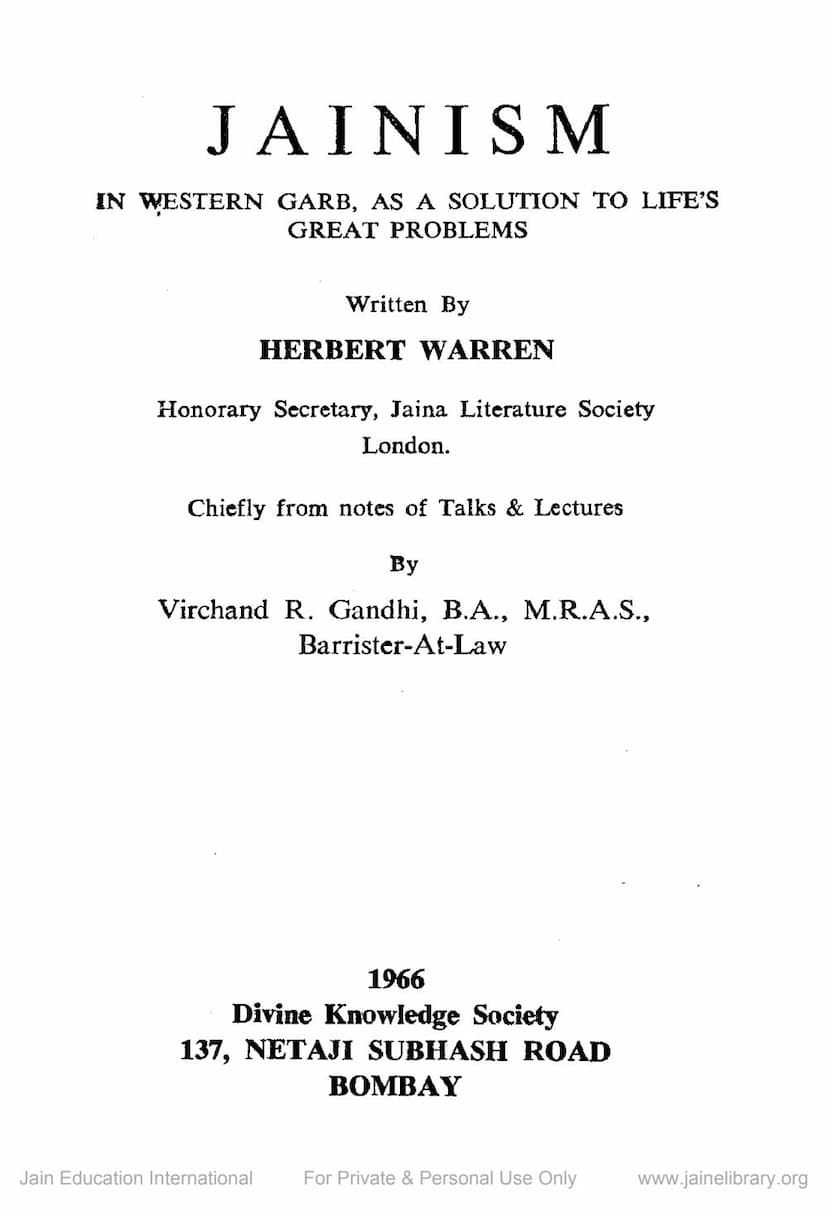Jainism
Added to library: September 2, 2025

Summary
This document is a comprehensive overview of Jainism, presented in English by Herbert Warren, with significant contributions and inspiration from Virchand R. Gandhi. The book aims to explain Jainism as a solution to life's fundamental problems, tailored for a Western audience.
Here's a breakdown of its content based on the provided pages:
Core Purpose and Approach:
- "Jainism in Western Garb": The primary goal is to present Jain principles in a way that is understandable and relevant to Western thought and culture.
- Solution to Life's Problems: The book posits that Jainism offers satisfactory answers to fundamental human questions about suffering, happiness, existence, and the human condition.
- Foundation in Gandhi's Teachings: Herbert Warren explicitly states that his understanding and presentation are largely based on notes from talks and lectures by Virchand R. Gandhi, an esteemed Jain scholar and exponent.
Key Philosophical Concepts Presented:
-
The Universe (Part II, Chapter II):
- Reality is Substance (Dravya): The universe is composed of real substances, which are eternal, uncreated, and indestructible at their core.
- Two Primary Substances:
- Jiva (Living Substance/Soul): Characterized by consciousness, knowledge, and self-activity. It is individual, not a universal soul.
- Ajiva (Non-living Substance): Comprises matter (pudgala), space (akasa), dharma (medium of motion), adharma (medium of rest), and time (kala).
- Proof of the Soul: The existence of consciousness is distinct from matter in motion, implying a separate, conscious substance.
- The Nature of Substance: Substances have general (common) and particular (unique) natures. They also possess qualities (guna) and modifications (paryaya).
- Ways of Knowing (Nayas): Jain epistemology emphasizes that truth can be viewed from different perspectives (permanent vs. perishable, etc.).
- Modes of Expression (Syadvada): The doctrine of conditional predication, acknowledging that statements about reality are always qualified, reflecting its complex nature.
- Causation: Jainism posits a dualistic causation: substantial cause (the thing itself in its previous state) and instrumental/determining cause (an external agent that influences change). Nothing is created out of nothing; all phenomena are transformations of existing substance.
-
Man as He Actually Is (Part II, Chapter III):
- Compound of Soul and Matter: Humans are a combination of soul (jiva) and matter (pudgala). This compound state is not natural to the soul.
- Karma: The combination generates "energies" or "karmas," which are subtle forms of matter that obscure the soul's natural qualities (knowledge, bliss, strength).
- Eight Classes of Energies (Karmas): The book details eight main categories of karmic energies that affect the soul:
- Knowledge-obscuring (Jnanavaraniya): Hinders direct and indirect knowledge.
- Perception-obscuring (Darshanavaraniya): Hinders the initial stage of awareness.
- Feeling-producing (Vedaniya): Causes pleasure or pain.
- Deluding (Mohaniya): Obscures right belief (Darshana-mohaniya) and right conduct (Charitra-mohaniya), leading to delusion, anger, pride, deceit, and greed.
- Lifespan-determining (Ayuh): Determines the duration of existence in different life forms (heavenly, hellish, human, animal).
- Form-determining (Nama): Determines the physical characteristics and types of bodies.
- Status-determining (Gotra): Determines one's social standing and family circumstances.
- Obstruction-causing (Antaraya): Hinders the performance of actions, generosity, etc.
- Causes of Karma: These energies are generated by four impelling forces: delusion (mithyatva), lack of self-control (avirati), passions (kashaya), and activities of body, mind, and speech (yoga).
-
Man as He May Become (Part II, Chapter IV):
- The Liberated Soul (Siddha): The ultimate goal is to become a liberated soul, possessing infinite knowledge, perception, bliss, energy, and equanimity, free from all karmic matter.
- Stages of Development (Gunasthana): The journey from an impure to a pure soul is described through fourteen stages of spiritual progress.
- Fourfold Difficulty: Obtaining human life, encountering true spiritual teaching, believing it, and practicing it are presented as significant challenges.
-
Means to the End (Part II, Chapter V):
- Stopping Influx and Removing Matter: The core means involve stopping the inflow of new karmic matter (samvara) and purging existing matter (nirjara).
- Three Processes: These processes lead to the "cutting of the knot" of worldly attachments and passions.
- Thirty-five Rules of Conduct: Practical guidelines for laypersons to help them progress spiritually and avoid spiritual decline. These are not commandments but are based on love and self-control.
- Twelve Special Rules/Vows (Vrata): These are more structured practices for those striving for spiritual progress, divided into lesser vows (for laypeople) and greater vows (for monks). These cover:
- Non-violence (Ahimsa)
- Truthfulness (Satya)
- Non-stealing (Asteya)
- Chastity/Fidelity (Brahmacharya)
- Limitation of Possessions (Aparigraha)
- Limitation of Area (Dig-parimana)
- Limitation of Use (Bhogopabhoga Parimana)
- Avoiding Useless Evils (Anartha-danda Viramana)
- Equanimity (Samayika)
- Limitation of Time/Space (Deshavakasika)
- Fasting (Pausadha/Upavasa)
- Sharing/Charity (Atithi Samvibhaga)
- Concentration (Dhyana): A crucial tool for self-development, understanding, and controlling one's actions. It involves analyzing and synthesizing knowledge, and focusing the mind on right conduct.
- Five Holy Persons: The text outlines the hierarchy of spiritually advanced beings: Arhat (Master), Siddha (Liberated Soul), Acharya (Spiritual Teacher), Upadhyaya (Scholar-Teacher), and Sadhu (Monk/Ascetic).
- Six Daily Activities: Practices like worship of the Master (or their image), homage to the teacher, study, self-control, austerity, and charity.
- Twenty-one Characteristics of a Layman: Qualities that indicate readiness for spiritual progress.
Overall Message and Tone:
The book emphasizes Jainism as a rational, ethical, and practical path to spiritual liberation and happiness. It highlights individual responsibility, the power of self-control, and the importance of compassion and non-violence (Ahimsa) as the supreme principles. The tone is explanatory and aims to bridge the gap between Jain philosophy and Western understanding, offering a clear, albeit detailed, exposition of its core tenets.